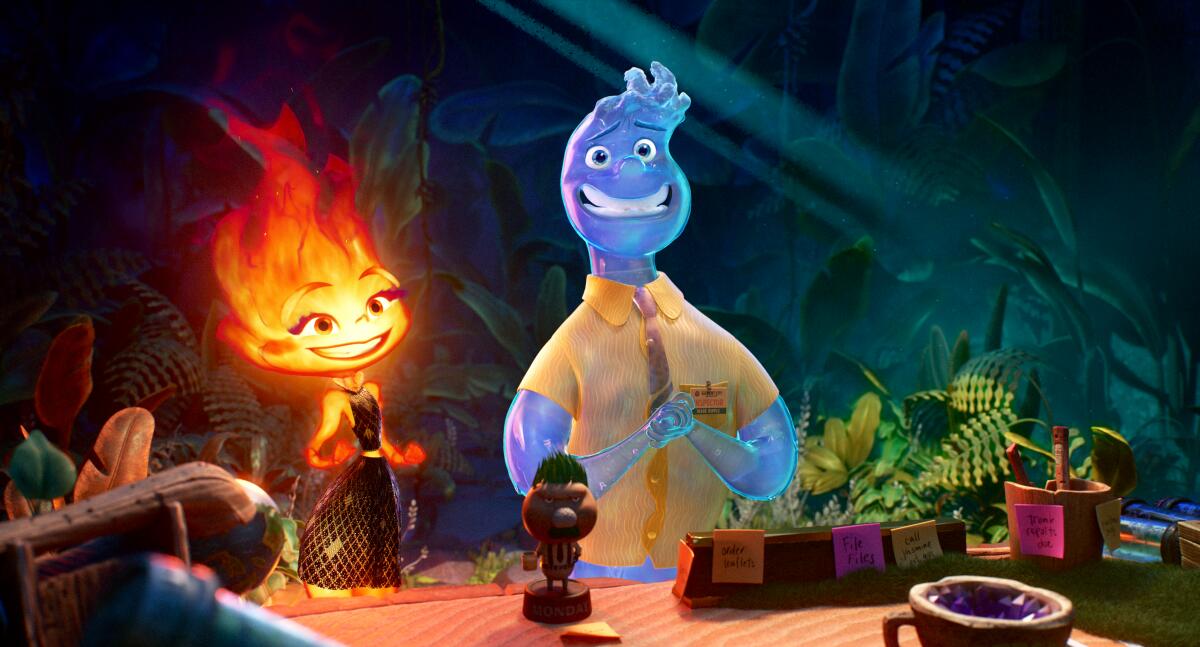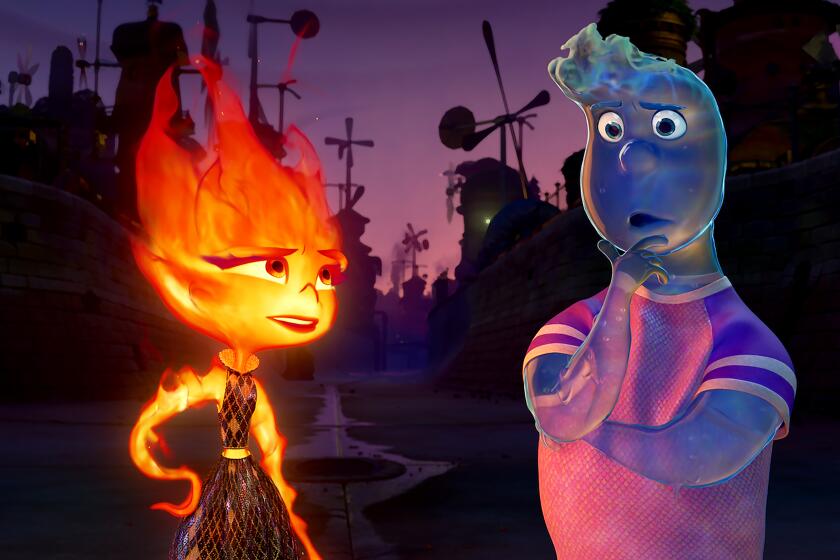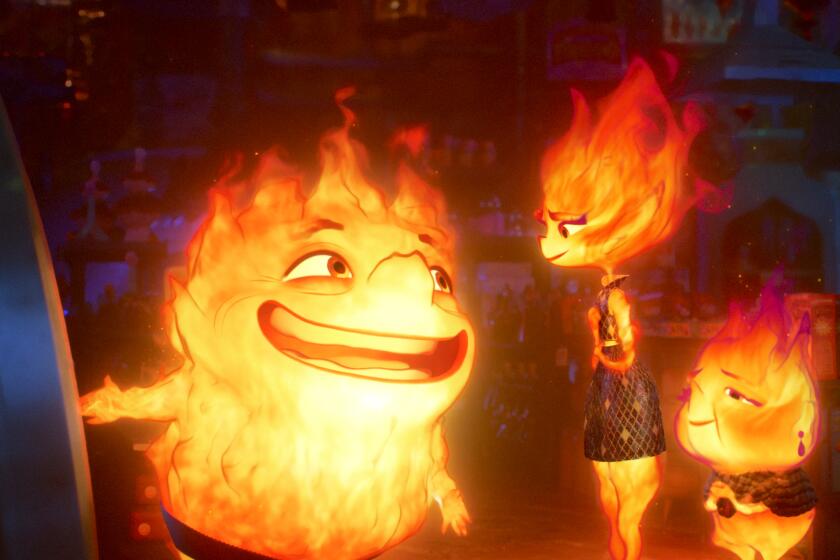‘Elemental’ animators keep the emotions burning bright without dousing the fun

- Share via
Never mind Elvis and Priscilla, two of the year’s most captivating movie hairstyles belong to Ember and Wade, the animated heroes of “Elemental.” In Pixar’s anthropomorphic rom-com, these star-crossed elements fall in love despite overwhelming odds: She’s fire, he’s water. To sell the distinction, animators crowned Ember with flickering spikes of flame-red hair while Wade sports an ever-gurgling aquamarine pompadour.
“Elemental” director Peter Sohn (the animated short “Partly Cloudy”) sets the story in Element City, where segregated tribes of fire, water, earth and air rarely cross paths. But Ember (voiced by Leah Lewis) meets-cute with Wade (Mamoudou Athie) during a flood and together, they run the gamut of emotions without benefit of blood, flesh or bone. “Elemental” visual effects supervisor Sanjay Bakshi says, “Our challenge mostly had to do with complementing our normal tools with a new set of tools that could layer on top in ways that gave our animators new forms of expression.”
Bakshi previously helped make dinosaurs and rats into relatable characters for “The Good Dinosaur” and “Ratatouille,” but those creatures already had eyes and mouths as starting points. The “Elemental” team built its characters from scratch by infusing rudimentary forces of nature with human-like attributes. Bashki and character supervisor Jeremie Talbot (“Brave,” “Lightyear”) talked to The Envelope about backyard fires, water hose tests and the art of soul-mate animation.
What was your creative brief from director Pete Sohn?
Talbot: Pete had a very specific iconography: Wade is a drop of water. His face shape is a drop, all his silhouette language is a drop, and so the sculpture of Wade reflected this drop morphology. Ember is the opposite; she’s like a candle or a campfire. Those [shapes] were built into their characters as this lovely throughline. The challenge came in how our animation department interpreted that [iconography] through motion — for example when Wade’s whole shape changes to emphasize his watery-ness.
Following the familiar “Romeo and Juliet” template, the latest movie from Pixar Animation puts a new spin on a tale of opposites attracting.
Like the scene where Wade squishes his entire body mass into a thin stream of water so he can slip through a chain-link fence?
But always coming back to that simple silhouette of the bottom-heavy drip language. And it was fun to watch Ember come through that fence, getting the barbed wire to bend and showing this little bit of glow. Those are shots that effects artists love doing because you almost can’t go too far on stuff like that.
What did you use as references to study how fire and water behave?
Bakshi: Early on we had people filming fire themselves in their backyards. And then there was that water hose test.
What’s the water hose test?
Talbot: During the middle of the pandemic, we were trying to communicate with each other about how Wade’s hair should work. If it’s a wave, the water would always be crashing over his face. But if you hold a water hose underwater in a bathtub, you actually see the shape of water changing, That [water hose test] became a way to ground Wade’s hair in the physical world.
Wade’s gurgling pompadour matches well with his roly-poly physique and go-with-the-flow personality. What about Ember’s flaming red hair?
Talbot: Pete wanted to always see three peaks in Ember’s hair, but regular fire does not want to behave in that way. We spent months trying to figure out how to do that, and it leads back to that campfire idea: Heat is always going up, water is always going down. Pete directed us to focus on the ethereal-ness of fire coming and going versus the weight and density of water.
How did the animators demonstrate what Ember’s going through emotionally?
Bakshi: We always start from a place where we can make a human act and perform at a very high level but here we are with a ball of fire. One of the more subtle things that we added is showing how Ember extinguishes, disappears and comes back. The animators came up with different ways for her to emote by eroding part of her flame, getting smaller, getting thinner.
For director Peter Sohn, ‘Elemental’ is a tribute to his Korean immigrant parents. It’ll make you want to say thank you to yours.
Talbot: And because Ember is not made of skin, we didn’t have to worry about skin folds. We were able to move the mouth around and detach the nose without worrying about their inner-connected surfaces because there is no surface. That gave animators more freedom to throw every idea anybody had into the [character] rigging and we could see what sticks.
“Earth” is cleverly personified by the bureaucratic Fern Grouchwood and the feisty Clod.
Talbot: We wanted these characters to feel like earth and not some stretchy painted rubber thing, so they’re actually made of chunks of earth and clumps of dirt.
“Air” takes shape as Wade’s fluffy pink cloud boss Gale Cumulus. How did you configure her?
We wanted to emphasize that Gale’s not just covered in puff balls; she is a cloud. There’s that moment at the [sports] stadium where Gale turns into a storm cloud with lightening and darkening. You can see her all the way from the other side of the stadium getting angry.
In the end, fire and water get together without turning into steam, but along the way, Ember experiences this dark night of the soul. How did you and your colleagues express her low point through animation?
It’s that moment on the beach where Ember dims as a candle — that was key. We wanted those [animation] tools to be as expressive as possible so we could sprinkle them throughout the film whenever Ember changed her mood.
More to Read
From the Oscars to the Emmys.
Get the Envelope newsletter for exclusive awards season coverage, behind-the-scenes stories from the Envelope podcast and columnist Glenn Whipp’s must-read analysis.
You may occasionally receive promotional content from the Los Angeles Times.








